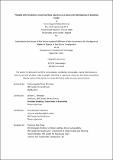Flooded with Possibilities: Analyzing Flood Insurance as a Catalyst for Development in Southeast Florida
Author(s)
Mejia Martinez, Carlos Augusto
DownloadThesis PDF (9.160Mb)
Advisor
Wheaton, William C.
Thompson, Anne Kinsella
Terms of use
Metadata
Show full item recordAbstract
Florida stands as one of the most critical residential markets in the United States, with residential sales reaching an impressive $468.5 billion and real estate residential investment amounting to $6.8 billion in 2022. However, the question arises whether this seemingly perpetual growth can withstand the tightening flooding policies. Is the residential market immune to the decisions made by insurance companies and the National Flood Insurance Program (NFIP)? These uncertainties form the basis of this thesis, which delves into the factors influencing insurance premium rates in Miami-Dade and Broward Counties, with a specific focus on geographic factors and independent variables.
Through the utilization of regression models, incorporating data from First Street Foundation and the US Census Bureau, the study analyzes the intricate relationship between these variables and premium rates. A key finding is the pivotal role played by geographic factors, particularly census tracts, in accurately predicting and comprehending premium rates. The inclusion of census tract data enhances accuracy and data normalization.
Moreover, several independent variables, such as flood risk, property values, mortgages, and rental affordability, emerge as significant influencers of premium rates. Time series data analysis reveals a steady upward trajectory in premium rates over time, accentuating the urgency for proactive measures in addressing the surge in insurance costs.
The research further identifies residential arbitrage opportunities, whereby developers can strategically acquire land in areas disproportionately affected by high premium rates. Approximately 15% of single-family homes within the census tracts of Broward and Miami-Dade Counties pay double the insurance dollar value compared to their peers in areas with similar characteristics, as depicted by FEMA. By considering demographic characteristics and purchasing power parity, developers can navigate the evolving real estate market and contribute to sustainable urban development.
These valuable insights into the factors influencing insurance premium rates open avenues for future research. Expanding the analysis to other geographic areas, incorporating additional variables, assessing the impact of climate change, and analyzing the effectiveness of mitigation measures are all potential directions for further exploration. Ultimately, this research sheds light on the intricate dynamics of insurance premium rates and paves the way for more informed decisions in the realms of residential real estate and urban development.
Date issued
2023-09Department
Massachusetts Institute of Technology. Center for Real Estate. Program in Real Estate Development.Publisher
Massachusetts Institute of Technology